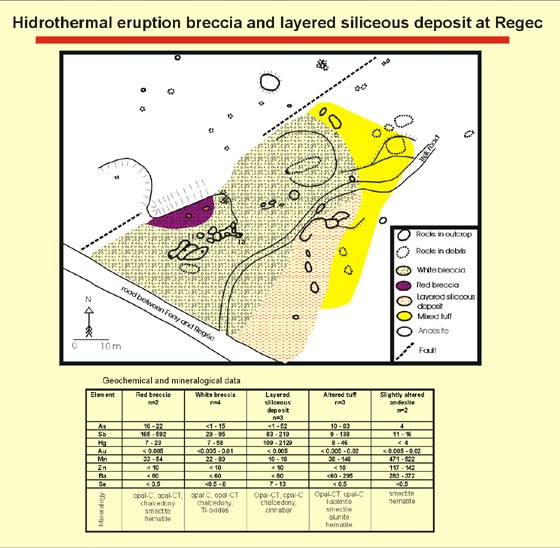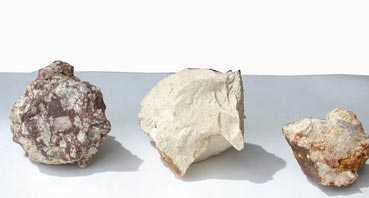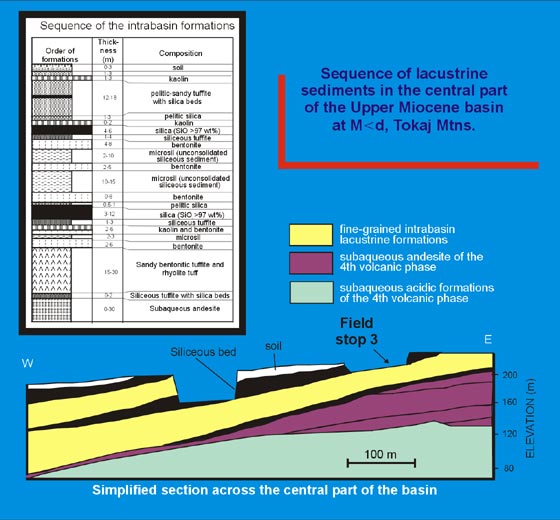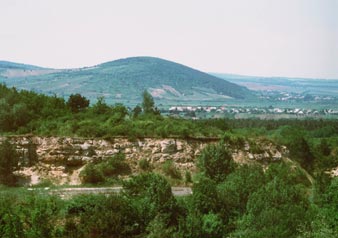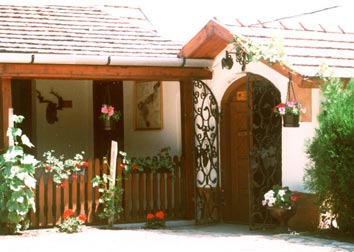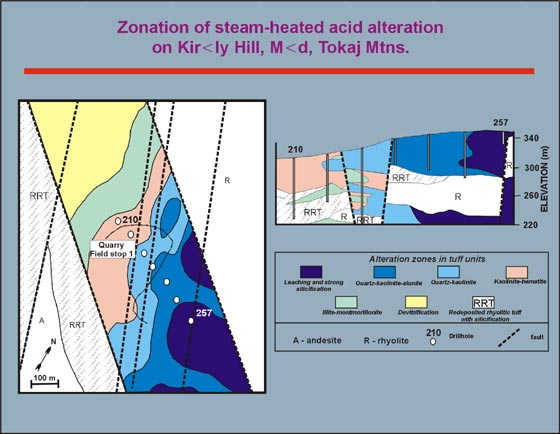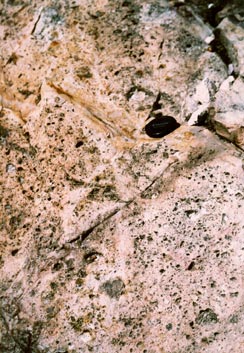| Tokaj Mountains Field Trip 2002: |
|
||
|
DAY-3. Central and Southern regions of the Tokaj Mts.
STOP-1: Gombás Hill in the Regéc Caldera, Central Tokaj Mts.
Local geology The volcanic center around the villages Regéc and Mogyoróska is located in the central-western part of the Tokaj Mtns. The surrounding hills form a ring at 500-700 m elevation around the local basin, which has a base at 350-400 m elevation. The center of the structure is indicated by an eroded remnant of an extrusive dome (520 m elevation). The basement in this part of the Tokaj Mtns. has a depth of about 1500-2000 m. The Badenian part of the volcanic series containing submarine dacitic and andesitic accumulations (Ilkey-Perlaki, 1968) was found in the lowermost part of the Baskó-3 (B-3) drillhole on the southwest margin of the structure (Fig. 11). The Sarmatian volcanic sequence is 880 m thick and is composed of acidic pyroxene-andesite and tuffs of the lower andesite unit. K/Ar ages from this sequence are between 12.6±0.8 and 12.1±0.5. Within and around the center, parasitic volcanic cones are present. The andesite lava flows contain several agglomerate, andesite and intermediate-acidic mixed tuff layers. The tuffs are bedded and contain angular andesite and pumice fragments. Accretionary lapilli predominate in some layers. At the bottom of the structure, the subvolcanic facies of the lower andesite unit is exposed. This unit is characterized by regional propylitic alteration (Gyarmati, 1977). The rhyodacite extrusive dome (11 .6~0.3 Ma.; Table 3) in the central-eastern part of the caldera is intercalated with 1-3 m thick pyroclastic layers composed of its own fragments. Pyroxene-amphibole dacite intruding the sedimentary-tuff sequence along the western side of the volcanic center is considered to be the subvolcanic facies of this rock (Fig. 11). The erosional remnants of the youngest lava flows of the upper pyroxene-andesite of the Tokaj Mts. occur at the highest elevations around or within the structure.
Hydrothermal mineralization There are three different styles of alteration, representing different levels of low-sulfidation type epithermal systems, occur within the caldera structure at Regéc: - hydrothermal eruption breccia with layered siliceous deposit - steam-heated alunite-kaolinite alteration in tuff units - quartz veins surrounded by adularia-sericite alteration in andesite
Hydrothermal eruption breccia with layered siliceous deposit The few meter thick hydrothermal products cover an approximately 1000 m2 area underlain by a lower andesite lava flow. This hydrothermal enviromnent can be divided into five zones (Fig. 12). A red, poorly-sorted and clast-supported breccia occurs in the center. The fragments (0.5 to 5 cm diameter) are well rounded and the red color of the matrix is from the presence of hematite. This zone is surrounded by a white, poorly-sorted and matrix-supported breccia with clasts ranging from 0.01 to 1 m size, that are sub-rounded to angular. Towards the eastern margin of the outcrop the maximum size and the number of clasts in the white breccia decrease and non-planar 1-3 cm thick layering appears. The outermost layered siliceous deposit contains 10-20 cm thick uneven beds gently dipping toward the central part of the volcanic structure. The mixed tuff that surrounds the zone of breccia and siliceous layers contains pumice, quartz, glass and andesite fragments (1-3 mm) and is characterized by argillic alteration (kaolinite and smectite), weak silicification (opal) and subordinate presence of alunite. The surrounding and underlying pyroxene andesite is partly altered to smectite (after plagioclase) and hematite-limonite (after mafic minerals). In the western part of the hydrothermal center the zonation cannot be observed due to the recent cover and erosion.7~0.6 Ma ages (Table 3).
The red and white breccias contain fragments from the layered siliceous deposit and silicified andesite. In the silicified andesite clasts, the space of the original rock-forming minerals is mostly filled up by fibrous calcedony. The matrix of white breccia contains concentrically laminated microscopic structures. According to XRD and IR spectroscopic data (Bajnoczi, 1997) the matrix of breccias as well as the mass of the layered siliceous deposit is composed by opal-C and opal-CT with less ordered structure towards the eastern marginal zones. Mercury is most concentrated in the layered siliceous deposit where cinnabar is present. Antimony shows the highest values in the layered and in the central red breccia zone. Arsenic is well below the local threshold value (136 ppm; Hartikainen et al., 1992) in each rock type. The textural, mineralogical and geochemical characteristics suggest that this outcrop represents a paleosurface of a hot spring center in which eruptions occurred during hydrothermal activity. The accumulated breccia was cemented by the precipitations from the outflowing fluids and the layered zones towards the margins represent a transitional zone to a silica sinter apron. Alunite-kaolinite alteration occurs in the central and southern part of the volcanic center at Regéc (Fig. 11) and represents the former existence of steam-heated waters. The host tuff beds are intensely silicified with microcrystalline quartz and opal. Alunite occurs as fine crystals (5-30 microns) in the matrix of the tuff and coarse-grained (0.2-0.5 cm), comb-textured aggregates in the fractures of the silicified rock. Kaolinite, illite and smectite form small (0.1-1 in), irregular bodies within the beds. The adularia-sericite alteration in the subvolcanic facies of the lower andesite represents the deepest level of hydrothermal effects at Regéc. This type of alteration follows N-S and NE-SW directions and envelops quartz veins (Fig. 11) that are 3-10 in wide and can be followed up to 1 km length. These subvertical-vertical veins are banded and locally brecciated. Adularia occurs as pseudorhombohedral crystals in 1-3 mm wide quartz veinlets as well as a phase that replaces plagioclase in a 50-100 wide argillic (illite and smectite) alteration zone around the veins. Distal alteration zones comprise quartz, smectite, chlorite and pyrite. The veins and their stockwork zones contain minor disseminated pyrite, hematite and secondary Mn-oxy-hydroxides. Liquid-rich and vapor-rich fluid inclusions in the vein quartz indicate boiling conditions. Typical homogenization temperatures are between 170 and 2100C, and salinities between 1.4 and 2.9 NaC1 equiv. wt0/o. These data indicate that the minimum depth of vein formation was between 90 and 190 in below the paleowater table (Molnár, 1993; Bajnóczi, 1997).
STOP-2: Siliceous and clay deposits in a hot-spring fed lacustrine basin west of Mád The sedimentary sequences of the lacustrine basin west of Mad crop out over an approximately 8 km2 area.The original size of the basin is not known because it is bordered by normal faults to the west and south. The basin history was reconstructed by Mátyás (1966) from observations of more than 460 shallow drillholes and exposures in open pits. The limnic sequence of the basin is underlain by a pyroxene andesite la~a flow related to the intermediate volcanic activity between the fourth and fifth rhyolitic tuff unit (Figs.7 and 10) of the area. The upper parts of the lava beds show shallow subaqueous accumulation with hyaloclastite breccia. In the lacustrine sequence, three major consolidated siliceous layers occur. However, there are unconsolidated beds (‘microsil’; Fig. 9) which are composed of uncemented quartz plates 5-20 ~m size and very little argillic material. The ‘microsil’ contains 93 wt % 5i02 while the silica content of the massive siliceous layers is above 98 wt%.
The
grain size of sediments gradually decreases, not only horizontally (to
the west) but also vertically in each cycle. Thus, the upper parts of
sedimentary cycles are characterised by pelitic sediments which show
intensive kaolinitic and bentonitic alteration around the hydrothermal
vents. The localities of feeder zones within the basin (Fig. 10) are
marked by this horizontal zonation of clay minerals (kaolinite close
to the feeder zones fringed by a montinorillonite halo) as well as by
the thickness of silica layers. Close to the centers, the thickness
of siliceous deposits is up to 10-1 2meters, while on the margins they
totally pinch out. In feeder zones within the basin, Mátyás (1979) also
outlined subaerial hydrothermal centers around the depression. These
centers now form small hills with strongly silicified and brecciated
rocks. The siliceous layers often contain petrified wood and fossilized
plants indicative of a shallow water or swamp environment. Typical plant
fossils comprise Gliptostrobus, Osmunda, Taxodium, Populus and Salix
species. Prints of Quercus mediterranea, Quercus kubinyii and
Acer decipiens leaves transported into the basin from the surrounding
areas are also common. The occurrence of non-thermal conditions during
the accumulation of the silicieous beds is reflected by the presence
of tortoise and fish fossils.
STOP-4 and 5 Steam-heated hydrothermal alteration and quartz veins northeast of MádThe mineralized zones and quartz veins of this area occur in various host rocks including rhyolite and rhyolitic tuff as well as andesitic rocks. K/Ar ages of alunite from the rhyolite of MogyorOs Hill range from 11.73 ±0.54 to 11.71 ± 0.29 Ma, whereas alunite from the layered rhyolite tuffofKiraly hill has an age of 10.85 ± 0.26 Ma (Table 2). These data suggest protacted hydrothermal activity in this area and are in the range of K/Ar ages for volcanic rocks. The large-scale vertical zonation of the hydrothermal alteration is clearly displayed by the M-23 drillhole (Figs. 6 and 8). The upper 50 m of the sequence is characterized by kaolinite-alunite alteration with silicification in andesite and andesite tuff. This is underlain by a zone of chlorite-carbonate-K-feldsparpyrite(smectiteillite) alteration in the subvolcanic andesite. The deeper zones (116-240 m) of this intrusive body are characterized by epidote-carbonate-pyrite(-chborite) alteration. Below 240 m depth K-feldspar is present again in the alteration assemblage. The vertical zonation of the hydrothermal alteration within and above the shallow subvolcanic intrusion corresponds to a typical low-sulfidation type epithennal alteration pattern, with propylitic zones at depth, adulariasericite(-chlorite-carbonate) alteration at intermediate depths and steam-heated kaolinite-alunite alteration of the shallow portion of the system (Silberman and Berger, 1985). STOP-4: Király Hill A horizontal zonation of the steam-heated alteration at shallow depths can be seen in the quarry of the Király Hill. At Király Hill the most intensively silicified zones in the fourth and fifth rhyolitic tuff units formed along a tectonic contact with the fifth stage rhyolite (Fig 9.) The silicification is most intensively developed in the porous rhyolitic tuff; rhyolite is altered only just along the fault. The silicified zone of the fifth tuff unit exposed in the quarry gradually changes into a kaolinite zone with decrease in the Si02 content (from about 95-98 Wt”/o to about 80 wt %) and increase of the Al203 content (from 2-3 wt% to. 10-11 wt%). The average sulfate content increases to about 3 wt %, but locally can be as high as 15-20 wt % (chemical data from Mátyas, 1966 and Varjü, 1974). Sulfate-rich zones also have 3-5 wt% K20, suggesting that the enrichment of sulfur is associated with the presence of alunite. Nemecz (1973) reported dickite in addition to kaolinite in the kaolinite-alunite zone. The kaolinite bearing zone is fringed by illitemontmorillonite alteration. According to Nemecz (1973), the illite-montmorillonite has an interlayered structure with ordered pattern of illite and montmorillonite layers (this type of clay mineral was described as ‘allevardite’ and ‘rectorite’ in the older literature). The outermost part of this alteration zone contains only montmorillonite.
In the strongly silicified zone the original texture of the rhyolitic tuff is totally masked by hydrothermal alteration. As the grade of silicification decreases towards the kaolinite-alunite zone, the rock becomes highly porous due to hydrothermal leaching. The resulting cavities are mostly found in pumiceous fragments and formed the preferred sites for precipitation of alunite. Alunite forms aggregates of fme-grained individual crystals (0.1-1 mm) with rhombohedral or platy habit. The 10.85±0.26 Ma K/Ar age reported in Table 2 was determined on cavity-filling alunite from this locality. Minor quartz, chalcedony and opal are associated with alunite. Very fine alunite is also present in the kaolinitic-siliceous groundmass of the rock. In the illite-montmorillonite zone the color of the tuff changes from white to grey/greyish-green. The Cavities formed by acidic leaching are less abundant and filled with illite-montmorillonite or montmorillonite.
No sulfide minerals were found in the alteration zones. The major Fe-bearing mineral is the hematite and other Fe-oxyhydroxides. The presence of hematitic patches and disseminations are typical in the marginal parts of the kaolinite-rich alteration zone (Mátyás, 1973; Fig. 9). Steam-heated alteration with alunite forms in a near-surface portion of a low-sulfidation type epithermal environment, where H2S exsolved through deep boiling is absorbed into steam-heated water and underwent oxidation to form H2S04 (Schoen at al, 1974; Henley and Ellis, 1983). At the paleowater table, massive silicification occurs in a porous unit, probably as a result of mixing of three different fluids: (1) acidic fluids descending and mobilizing silica from the acid-leached zone; (2) ascending near-neutral, also silica rich hydrothermal fluids and (3) cooler aquifer fluids (Schoen at al., 1974; Sillitoe, 1993). The horizontal zonation with less acidic character of alteration moving apart from the silicified and kaolinite-alunite bearing zones suggests lateral flow of fluids along the paleowater table at Király Hill.
STOP-5: Bomboly HillAt Bomboly Hill, Field stop 2, (Fig. 6) a steam-heated alteration zone formed in the fourth rhyolitic tuff unit of the area is exposed. The argillic alteration zone was mined for kaolin up to the beginning of the 1 970s. The kaolinite-dickite-alunite alteration zone is a funnel-shaped body around a swarm of quartz veins. The surroundings of veins are silicified in a 20-3 0 m wide zone (siliceous kaolinite zone). Alunite enrichments occur in irregular pockets. Whithin the kaolinite bearing zones Fe-oxide minerals are present. Zones outward and downward from the alunite and kaolinite bearing alteration contain halloysite, montmorillonite and illite-montmorillonite assemblages with disseminated pyrite. The quartz veins contain 1.7-2.4 g/t Au and 10.7 to 15.8 g/t Ag; the silicified kaolinite-alunitealteration selvage assayed 0.4 g/t Ag (Csongradi and Zelenka, 1995). The quartz veins have a banded texture with alternating massive and porous white and greyish bands. Based on thin-section petrography, the massive bands are composed of microcrystalline quartz and the color zonation is related to the variation of the grain size and not to the sulfide content. The porous, spongy bands often contain quartz pseudomorphs after several centimeter long bladed calcite crystals. Bladed calcite may deposit from a boiling near-neutral pH fluid in low-sulfidation environments (Simmonsand Christenson, 1994; Hedenquist et al., 1996). The replacement-dissolution of bladed calcite by qartz occurs during the subsequent cooling due to retrograde solubility of calcite (Fournier, 1985). The occurrence of funnel-shaped alunite bearing kaolinite alteration zone around the quartz veins with pseudomorphs of bladed calcite indicates overprinting of the deeper alteration environment by acidic steam-heated water. The appearance of steam-heated fluids in a formerly boiling part of a hydrothermal system can be expleained by the downward migration of the paleowater table during hydrothermal activity (Simmons 1991; Sillitoe, 1993). In the Tokaj Mtns., tectonic uplift took place during the Sarmatian-Pannonian volcanism and this may explain lowering of the paleowater table during the protracted hydrothermal activity at Mad. In addition to the occurrence of bladed calcite, fluid inclusion evidence
also supports the boiling of early fluids at Bomboly Hill. Vapor-rich
and liquid-rich fluid inclusions are associated with calcite inclusions
along the growth zones of euhedral quartz from cavities in rhyolite
underlying the altered tuff horizon (Molnár and Bajnóczi, 1997). Microthermometric
data indicate that boiling fluids had 1 80-2000C temperature
with 1-2 NaC1 equiv. wt% salinity. Thus the minimum paleodepth below
the water table was 100-160 m. Fine-grained quartz replacing bladed
calcite also contains an inclusion generation with similar data, but
its secondary fluid inclusions display much lower homogenization temperatures
between 130 and 1 600C. The salinities for these inclusions
of replacement quartz are also between 1-2 NaCl equiv. wt0/o.
These secondary fluid inclusions reflect slightly higher temperatures
for late fluids than the typical, less than l00-1200C temperature
for acidic steam-heated waters (Schoen et al., 1974; Hedenquist and
Arribas, this volume).
|
|||

